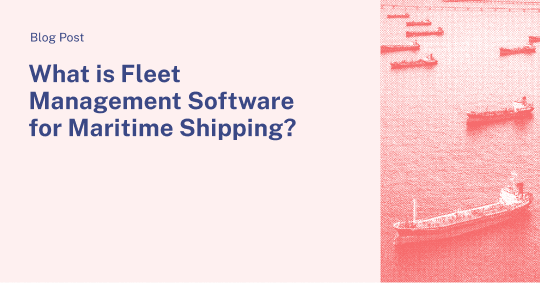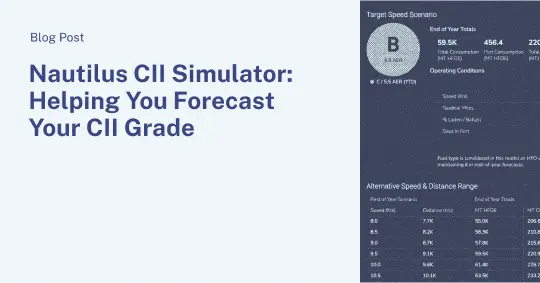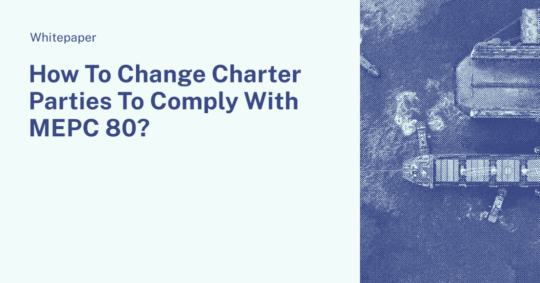The maritime industry is facing increased pressure to reduce its greenhouse gas emissions (GHG). The International Maritime Organization (IMO) set the target to achieve net zero at or around 2050.
Earlier this month, the Marine Environmental Protection Committee (MEPC) came together to further discuss the maritime industry’s objectives to achieve the shipping sector’s decarbonization efforts. While we have discussed the outcomes of MEPC80 as well as the regulatory landscape (including the Carbon Intensity Indicator (CII) or the Energy Efficiency Index (EEXI)) in previous blog posts, it is clear maritime transport has a long way to go to become more sustainable.
Meanwhile, crude oil prices fluctuate and S&P only has a cautiously positive market outlook for Q3 of 2023. Dry bulk demand is projected to increase this year (mainly due to iron ore and coal shipments) while bulk freight rates as well as box rates are declining. However, supply normalization and fleet growth, along with stricter regulations, will contribute to the stability of the shipping markets. Given the ever-changing market environment, initiatives to manage costs and fuel consumption have become increasingly important.
Efficiency gains in the maritime shipping industry today are not solely reliant on traditional methods but are increasingly driven by better decisions based on improved information, data, and technology. Embracing these advancements can unlock a world of opportunities for shipping companies looking to streamline their operations, enhance sustainability efforts, and navigate the challenging waters of compliance. However, these advancements can be difficult to achieve using current charter parties frameworks.
Are noon reports still good enough to use in charter parties?
The prevailing status quo in charter party agreements relies heavily on noon reports as the source of truth. Noon reports are submitted once a day. With weather potentially varying massively throughout the day, noon reports are either averaged out or only account for a moment in time. Furthermore, the intention of a noon report can vary: Who reports and for what reason? For example, for vessels on time charter, focusing the noon reports on a period where the weather is calmer could help with performance claims against the owner.
In order to understand true vessel performance, shipping companies establish static performance benchmarks that provide a performance baseline for the ship – the worse performance gets over time, the further it moves away from this established benchmark. However, if there’s a lack of granular data sets, this benchmark can only ever be a static moment in time.
Without access to high-frequency data and digital twins, owners and charterers fail to make optimal technical and operational decisions. Shipowners might follow an arbitrary vessel maintenance schedule, resulting in unnecessary or overdue drydocks, whereas charterers lack information to determine the optimal route and speed for their upcoming voyages.
With noon reports as the underlying foundation of charter parties, such frameworks are based on static vessel performance descriptions and static speed and consumption tables. The lack of high-frequency data in real-time can ultimately result in vessels sailing below peak efficiency and emitting excess CO2 emissions.
How can high-frequency data be used in a charter party agreement?
To overcome the limitations presented by noon reports, shipowners and charterers should embrace high-frequency data as the new benchmark in their charter party agreements. By leveraging high-frequency data, owners and charterers gain transparent and accountable data sets and information to improve operational and technical performance of the vessel.
Noon reports are submitted manually once per day, whereas high-frequency data is submitted automatically throughout the day and can contain hundreds of thousands of individual data points. Most vessels are already equipped with sensors and might have the ability to submit data collections from ship to shore. Especially when combined with AIS data and noon reports, this cost-effective investment provides a full, contextualized picture of ship operations.
Data is more powerful if turned into actionable information. Leveraging high-frequency data to inform digital twins empowers shipowners and charterers to understand and simulate true vessel performance and predict and optimize voyage outcomes in line with e.g. weather forecasts, fuel costs, or trade routes. These digital twins serve as the “clean baseline” – a benchmark of optimal performance – alerting owners and charterers of performance degradation for optimally timed maintenance schedules and empowering better decision-making.
As Peter Drucker once said, “You can’t manage what you can’t measure”. So, the more data going into the measurement process, the better you will be able to manage your assets, regardless of ship size, such as capesize, aframax, or panamax; ship type, such as oil tanker or bulk carriers; or ship design.
What does the future of charter parties look like?
Despite the clear disadvantages of noon reports, shipowners might be hesitant to base charter parties on high-frequency data given the fear of increased claims exposure. Shipowners establish ship descriptions and warrant a certain vessel performance. If the actual performance is below the agreed-upon benchmark, charterers can file a claim. Access to high-frequency data on vessel performance makes it easier for the charterer to see if the vessel is performing below the warranted speeds and so bring a claim.
But this is why it is important to transform the underlying structures and adjust charter parties to provide upsides for both parties: owners and charterers. With accurate digital twins based on high-frequency data, owners and charterers can move away from static ship descriptions – which open the door for claims and financial penalties – and instead work together based on dynamic ship descriptions.
The commercial partnership between the stakeholders should be rooted in aligned incentives and joint KPIs with the goal of ensuring optimal vessel performance and efficiency, both operational and technical. With shared high-frequency data being the underlying data set, owners and charterers are equipped to use cost-effective technology that powers better decision-making while still maintaining data privacy.
The upside is clear: high-frequency data can be used to determine charter rates based on real-time performance, manage technical vessel efficiency, make better operational decisions to optimize voyages, tackle increasing fuel prices, improve maritime economics, and reduce CO2 emissions.
High-frequency data enables shipowners and operators to better manage their vessels and stay compliant with new regulations
The regulatory landscape in the ocean supply chain has changed dramatically over the past years. In this more complex environment, we find ourselves necessitating revamped frameworks. The legal agreements of the past are no longer sufficient to navigate the ever-changing landscape of the maritime industry, especially in the face of emissions regulations. Previously, there was no incentive to change data sets within charter party terms as shipowners did not gain an advantage but feared negative exposure. However, today’s technology enables shipowners to maintain data privacy and creates an incentive for making high-frequency data the source of truth for transformed charter parties.
Green Charter is our approach to updating charter frameworks with modern solutions. Transformed charter parties create aligned incentives and foster trust and shared interests between owners and charterers. Utilizing digital twins as unbiased sources of truth, stakeholders gain the ability to make informed decisions on speed, routes, maintenance, and vessel marketing. By dismantling barriers and promoting collaboration, this innovative commercial framework applies to both voyage charters and time charters, enabling high-frequency data sharing on the international shipping industry’s path of achieving net-zero emissions by or around 2050 in line with MEPC 80.


